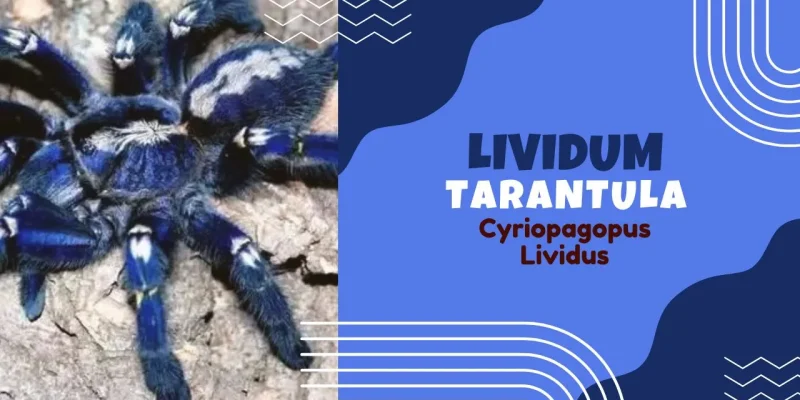Cyriopagopus lividus is the scientific name for the Lividum tarantula, one of the most amazing spider species. Its strange walk and beautiful blue color caught the attention of scientists and spider lovers worldwide.
In this article, we will learn about the fascinating world of the Lividum Tarantula. We will discover what this beautiful spider is, how scientists study it, and what we can learn from it.
What is the Cyriopagopus Lividus?
Cyriopagopus Lividus is a spider that lives in Southeast Asia and is also called the Tarantula or the cobalt blue tarantula. This type of spider is most likely to have come from Myanmar and Thailand. They look really good on guys because of the bright blue color.
Lizard tarantulas are spiders that live in burrows. To live, they dig holes in the ground. The wet, dark leaf litter on the ground of tropical forests is a good place for them to live. tarantula blue cobalt is hard to figure out because they don’t like being out in the open as much as other tarantulas do.
Why is the Lividum Blue Tarantula So Colorful?
The cobalt blue spider dark blue color finds several useful applications. First, it helps them to be less conspicuous in the outdoors where they are most usually found. Their hues help them to hide on the forest floor’s leaf litter, where they escape predators.
Besides, this vivid hue grabs the interest of possible partners. Men show their vivid colors freely to draw in women during the mating season. This intriguing feature of their behavior emphasizes the fact that survival and reproduction depend critically on appearance.
The Science Behind Its Stunning Blue Color
The attractive shade of blue of the Tarantula comes from both its structure and its pigments. What structural coloring is all about is how light bounces off of something, in this case, the surface.
The spider’s color, on the other hand, comes from the pigments it has.
The Tarantula is such a bright blue color because of tiny structures on the outside of its shell that reflect light. The spider looks very beautiful and bright because light bounces off of every part of its body.
Fun Facts About Its Habitat and Behavior
• Habitat: Lividum tarantulas usually live on the edges of tropical forests, where they dig complex and detailed burrows. They do best in damp places because it helps them keep their water levels in check.
• Behaviour: The spiders are very protective of their area. They stand on their hind legs and show their fangs to scare away predators and other people they don’t want to be around. Most of the time, they will try to stay in their holes and avoid people and other animals as much as possible.
• Nutrients: the majority of their food is roaches and bugs. Because they are quick, they are a great way to hunt.
The Unique Features of the Lividum Blue Tarantula
Lividum Blue Tarantula distinguishes itself with some special qualities. Tarantulas feel their environment quite well as their long, hairy legs and vivid blue hue guide them. It is well known that some spider species use the hairs on their bodies to detect their surroundings. These hairs can detect changes in air pressure and motions.
With its large teeth, this spider raises its food off the ground when grabbing it. Venom is released when it bites, maybe killing the bug and simplifying eating. These are most certainly strong predators with their lightning-fast reflexes, rapid movements, and great strength.
How Scientists Study the Cobalt Blue Spider
To study the cobalt blue spider, called lividum blue tarantula, researchers look at what is already known and what they learn new. This spider has many interesting traits, so researchers want to learn more about where it lives, how it acts, and what is around it.
Cool Technology Used to Watch Tarantulas in Action
Some tools have been created by researchers to help better grasp Tarantula ecology and behavior. They make quite intriguing use of high-speed cameras. These high-definition cameras will enable scientists to investigate how this spider hunts and, most likely, how it interacts with its surroundings.
Scientists, using high-speed cameras, can observe the lightning-fast pace at which the spider executes the act as it leaps upon its prey. This clarifies more how effective the hunting techniques of this arachnid are and how it modulates them to catch many bug kinds.
Learning About the Tarantula Blue Cobalt’s Habits with New Tools
High-speed cameras and a tracking gadget follow the Tarantula. The tracking gadget is light and somewhat small. It cannot thus damage the spider in any kind. Following it around will help researchers quickly grasp its home range, feeding patterns, and social interactions.
Important subjects for investigation in this would include its lifetime and whatever part it might play in the ecosystem overall. It also enables the researcher insight into what environmental factors can influence their survival chances.
Watching Cobalt Blue Tarantula Spiderlings Grow
Interestingly, there is an area of study that looks at how cobalt blue tarantula spiderlings grow up. Small tarantulas, which are sometimes called “spiderlings,” change a lot as they grow up and become adult spiders. Scientists can better understand factors that affect their growth by following them using a variety of methods and new tools.
Tracking the Growth of Spiderlings with Modern Tech
Learning about the spiderlings, which are sometimes called “infant tarantulas,” is fun and interesting in and of itself. At this point, people could see how the spiderlings grow from different positions. One way to do this is to use camera technology that was made to record their growth over time.
Thanks to recent advances in technology, scientists have been able to see spiderlings grow up to become fully grown adults.
Scientists watch spiderlings for at least the first few months of their lives to learn how they stay alive in their surroundings, what they eat, and how they stay away from birds of prey. This kind of scientific study can help us better understand what they want and why they do what they do.
How Technology Helps Us Understand Their Development
Scientists can follow spiderlings’ development throughout their life cycle. Researchers are examining various factors such as development rate, dietary patterns, and survival strategies. For example, they are studying the survival rate of spiderlings to adulthood and identifying the environmental factors that influence their success or failure.
Those who keep Lividum Tarantulas as pets may find great benefit in knowing these growth trends. It will ensure that you provide the spiderlings with appropriate care, which is essential for their well-being and overall health.
How the Lividum Blue Tarantula Inspires Technology
The cobalt blue tarantula, known as Cyriopagopus lividus, is a fascinating creature that has inspired new ideas in technology. By studying its unique features, engineers and scientists can develop better materials and robots.
Using Tarantula Movements to Create Better Robots
The Dark Green Engineers have created robots that move like tarantulas. These robots can find their way through tough environments, making them more useful and creative.
Engineers designed robots that can crawl over obstacles and enter hard-to-reach areas, mimicking how tarantulas dig. These robots can be used for search and rescue missions and exploring places that are difficult to access.
Examples of Robots Inspired by the Cobalt Blue Tarantula
The way the Cobalt Blue Tarantula moves has sparked many robot projects. Roboticists have made machines that can jump and climb like tarantulas. The robot can be used for many things, like looking at parts of buildings that can’t be reached and getting through the most difficult areas after a disaster.
Researchers have found that studying the tarantula blue cobalt can improve the design and usefulness of robots. Engineers can use this information to make machines that are more useful and flexible. This is just one example of how studying things in nature can help people make better technology.
Protecting The Cobalt Blue Tarantula: Tech for Conservation
The Cyriopagopus lividus, or cobalt blue tarantula, is an amazing animal that is an important part of its environment. It faces the same problems as all the other animals in the world: territory loss and changes in the weather. Scientists and environmentalists can handle these rare spiders better now that technology has improved, which means they will have a good future in the wild.
Using Drones to Keep an Eye on Their Habitats
Though climate change among other things compromises this species in the wild, the cobalt blue spider is quite lovely. Using drones, researchers track the habitats of such spiders from the air, therefore ensuring their safety. Scientists will be able to gather data on the surroundings and spider population as drones can land and map inaccessible locations.
Using drones, for instance, an expert might therefore acquire significant knowledge on the condition of an ecosystem where Lividum Tarantulas reside. They can track variations in flora, temperature, and other things that would affect the survival of spiders.
How Technology Helps Us Save the Cobalt Blue Spider
Besides drones, other tools can help scientists study cobalt blue tarantulas and find better ways to keep them safe. By understanding how changes affect their homes, we can help scientists protect the environment. This means spreading the word about why it’s important to save natural areas and working with other cities to create friendly spaces for wildlife. Technology is key to helping cobalt blue tarantula survive in the wild.
FAQs
What does the Lividum Tarantula eat?
The major diet of a Lividum Tarantula is bugs. Some of their best foods include the following: crickets, roaches, and mealworms. They are also good hunters that hunt using their speed and stealth. After biting the insect, venom drips into its body paralyzing it temporarily.
Are Cobalt Blue Spider Dangerous to Humans?
Most of the cobalt blue tarantulas are harmless to humans. The stings are painful, but they won’t kill you. The poison of the cobalt blue spider has the same potency as a bee sting. However, if you encounter one, be careful, and give it space.
You may keep the Tarantula Blue Cobalt as Pets.
Many people maintain a species called the cobalt blue tarantula as pets. They are very fascinating animals but take special care to be well kept. Thus, they require the correct humidity, temperature, and space to live in. More importantly, providing an environment that represents the real habitat for them is important.











